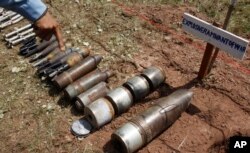A U.S. decision to cut funding for a demining program in Cambodia threatens to further worsen a feud between Phnom Penh and Washington.
On Tuesday, it emerged through local media reports the U.S. had decided to discontinue annual funding in 2018, worth about $2 million, to clear explosive remnants of war in Cambodia.
Prime Minister Hun Sen reportedly responded to the surprise decision by declaring he will stump to raise the money, according to a senior Cambodian demining official.
No public explanation has been given for the cut, and both the Cambodian Mine Action Center (CMAC), the final recipient of the funding, and Norwegian People’s Aid, which administer the money, say they do not know why the funding has been discontinued.
CMAC Director General Heng Ratana said he had no warning of any cut to the funding before he received notification Monday about the decision. The money covered the salaries of about 300 staffers, many of whom were deminers.
“I don’t know what the real dispute [is]. We just present the facts and we work together; they never indicated any dispute that we have had, but suddenly they cut the aid,” he said.
“But we are very lucky that the government, the head, the prime minister, granted approval that he will maintain our operation as usual so that means it has no impact on our operation,” he said, adding that funds for the rest of this year had not been affected.
The United States had a moral obligation to deal with the legacy of its bombing of Cambodia during the Vietnam war, he added.
Ruling Cambodian People's Party spokesman Sok Eysan told VOA he was unaware of the cut, which seemed peculiar to him.
“I think that it’s an issue which we see that it’s not normal. So, no matter what we answer, it will still be not normal,” he said.
Norwegian People's Aid country director Aksel Steen-Nilsen said he, too, had been unaware of the reasons for the cut.
“I mean, of course, there is a lot of rhetoric between Cambodia and the U.S. right now,” he said. “But ... I don’t see any specific objective related to this because it’s the end of the grant cycle, and then, of course, it’s up to the donor if they have funds and interest to continue or not.”
Steen-Nilsen said cooperation had been good thus far over the three years the grant had been running and there was no indication of any special reason it would stop.
In an email, the deputy spokesman of the U.S. embassy in Phnom Penh, David Josar, said demining remained at the top of the State Department's assistance priorities, but he did not address the specific reason for the cut.
“We will use 2018 resources to put in place a world-class removal program targeting U.S.-origin UXO [unexploded ordnance] in eastern Cambodia,” he wrote. “UXO experts have proposed that the United States devotes more attention to clearing such UXO, in addition to our support for clearing the more lethal Chinese, Vietnamese, and Soviet land mines in western Cambodia.”
Next year’s funding would be opened up to competitive bidding with requests for proposals — prepared in consultation with the Cambodian government — to be released this year, he wrote without providing any further details.
For months, Cambodia has accused the U.S. of fomenting a color revolution — a conspiracy plot it has used as the grounds to jail the country’s opposition leader, Kem Sokha, and justify moves to dissolve his party.
They have seized on the continuing impacts of unexploded ordinance left over from the U.S.’s massive illegal bombing campaign during the Vietnam war — a line of attack only bolstered by news of the cut to CMAC funding.
Carl Thayer, an emeritus professor at the Australian Defense Force Academy, said the embassy reports he had read also did not seem to be specific about the reasoning for the cut.
“So we don’t really know the reason why the funding was cut so far, and it’s sheer speculation on Hun Sen’s part and political opportunism on his part to make that linkage,” he said.
Any retaliatory action by the U.S. in response to the decimation of Cambodia’s opposition party would have been made up front, he said.
“There’s an expression, ‘between conspiracy and cock-up, you always go for conspiracy, and that seems to be what the Cambodians are doing, and until I see a better explanation, I’m saying its just a bureaucratic decision probably made in Washington and passed through without much thinking,” he said.
Josar said the U.S. had spent more than $131 million on the remediation of explosive remnants of war in Cambodia.
In recent years, the main focus of that funding has been on U.S.-dropped unexploded ordnance left in Cambodia's east. Some experts have complained this diverts resources away from more harmful explosive remnants in the west.








